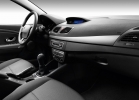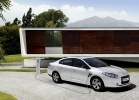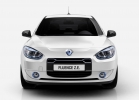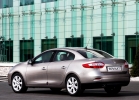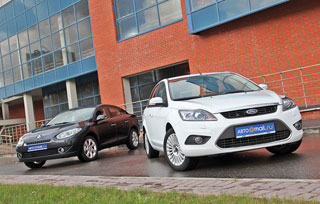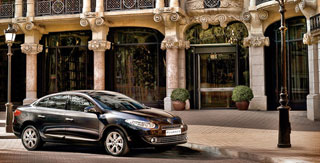Test drive by Renault Fluence since 2009 sedan
Testing the Renault electrical drives
Ecocenter Sokolniki. To present electric vehicles, it is better not to come up with a place. Oasis of freshness and coolness. Greens, birds chirping, mothers with strollers, cyclists in general, paradise. Here Renault demonstrated two electrical developments that will soon appear on the conveyor, a five -seater sedan Fluence Z.E. and commercial van Kangoo Z.E. But those cars that managed to travel were pre -production

Z.E. Deciphens as Zero Emission, that is, zero emissions.
The range on one charge of Fluence Z.E is in mixed NEDC 185 kilometers, Kangoo Z.E. 170
Fluence Z.E. The herring, neither give nor take. Squirrel licked silhouette, long base, heavy trunk. Electro-Flyuns is 13 cm longer than its analogue with ICE. The increase in length fell on the rear overhang. It is there that behind the seats of the rear riders in the trunk under a wide rear stand, a massive box with a traction battery is vertically located vertically.

Pay attention to the Renault Fluence Z.E. To the left of the speedometer indicator of the battery charge level. On the right is a switch economy meter. Almost all of the same information is displayed on a small display of the on -board computer as the usual flimes of the transmission mode, long -range, average speed, but the main thing is not this, and small numbers in the upper part of the display are a power developed by the engine. Press the gas, values \u200b\u200bcrawl up. You release values \u200b\u200bby jumping over zero, they are indicated with the sign Minus Power Installation passed into the recovery mode and recharges the battery
In the salon of electric flime, no yota did not become closer, it is still a roomy five-seater sedan with a bunch of space from behind. But the rear seats for transporting large -breasts now, of course, cannot be folded a battery. She, despite the increased body length, grabbed a fair part of the trunk. Now it has 300 liters (in standard flime 530). There is no spare wheel, but there is a secret niche. And what's under the hood?

Power installation 70-kilowatt (95 hp) synchronous electric motor of alternating current with excitement from electromagnets and a single-stage transmission with the main transmission. Some hybrids and electric vehicles have a reverse rotation of the rotor of the generator motor, but here the rotor and the shaft always rotate only in one direction, like that of ICE. Therefore, the transmission has a reversing.
I sit behind the wheel, clap the door. Salon is like a salon. Double -zone climate, navigation. Nothing special. Only the dashboard is other blue scales, a speedometer marked up to 150 km/h and a couple of new indicators showing electricians. On the left, instead of a tachometer, the battery level indicator. And the right scale of the fuel level sensor is replaced by an economy meter. Unification according to the full program!

Fluence Z.E.
Fluence z.e. Three -phase, with excitement from electromagnets.
Work voltage 400 volts.
Maximum power 70 kW (95 hp).
The maximum torque is 226 nm.
The maximum rotor speed is 11,000 rpm.
The transmission is single -stage with reverse transmission.
The block-connector is simply a box of connectors, to which high-voltage wires are connected.
The charger during charging the traction battery converts the alternating voltage of the external power supply into a permanent one.
The inverter converts a direct current of the traction battery into alternating current. He also converts the alternating current obtained by recuperative braking by the generator with a constant current for recharging the battery.
The battery is lithium-ionic, it is located on the back vertically on the subframe in the box, which protects it during the blow. The battery capacity is 22 kWh, operating voltage 400 volts. In the accident, the battery is turned off automatically. Interesting moment! Renault, in order to reduce the cost of his electric vehicles, sells them without a battery. That is, the battery, of course, is in them, but the company leases it at the cost of about 70-80 euros per month. It turns out that the battery ransom is carried out in installments. By the way, if you decide to sell the car after a short use, the battery rental contract is renewed to the new owner. Marketing rules the world
Even the ignition lock and the modes selection selector are the same as on the standard flimes I turn the key to a fixed position. The arrows come to life, the bulbs are moving. Then a couple of seconds awaiting until the gut wakes up. Now a spring -loaded start. And silence aaaa. Everything, the electrician is ready for action. A selector to D can go. I give it to the accelerator, the electric car silently accelerates forward.
And the dynamics, confess where it was better than I expected. Especially at low speeds. It is not surprising, the maximum traction (226 Nm) the electric motor develops at the very bottom of the range. But acceleration remains only up to 60-70 km/h, further with a set of speed, the flimes are monotonously thinning. No, not because he lacks strength. This is done on purpose, to save the charge. And in the end, Fluence Z.E. He gets to a hundred in 13.4 seconds. For a long time? Never! Compare, a gasoline sedan with a 106-horsepower 1.6 and an automatic transmission does this exercise in 13.9 seconds.
I taxi from Sokolniki to the city. Traffic, traffic lights, intersections, rubber police sod at Z.E. Exactly so much so that in a fussy urban environment not to be a white crow, no more. And I do not lag behind. I'm with a stream on the same wavelength. I get into the rhythm. Hooray! I get and catch myself thinking that it is just blasphemy to the accelerator once again. The pedal is clap, and now minus 2 kilometers. There were no more 3 more. Energy in the battery melts me-e-e-day, but inevitably. As you imagine that for charging a completely devastated battery with a capacity of 22 kWh you need an average of 7 hours, immediately you involuntarily take your leg over yourself. Coast of the charge, coast
After several kilometers, you involuntarily change the style on an electric car. You yourself notice that accelerations and slowdown have become smoother, speed below, the shooter of the economy meter is less and less sent to the red zone. And you begin to use less with ordinary brakes. It is in the management of traction that the main reserve of economy is hidden, this is true for any car.

There is no question of any LED technique. All optics, even head, on incandescent lamps. But the energy consumption of diodes is much lower!
But in general, the tactics of driving in urban conditions on an electric car is this: you need to accelerate as slowly as possible to the speed necessary at this section and as timely as possible before obstacles to release gas. For what? In order to collect the maximum kinetic energy back into the battery. As soon as you release the gas, the power plant goes into the regime of recuperative inhibition of the electric motor becomes a generator, it recharges the battery and at the same time develops a rather large braking force. What does it mean in a timely manner? If the gas is released later than necessary, the efficiency of braking with a power unit for these conditions may not be enough, and then you will have to follow the energy with ordinary hydraulic brakes, which could be recovered (returned) back into the battery, we took and barbarously converted into heat with the help of brakes. That is, they simply lost. But it was possible not to accelerate at all higher than a certain speed, so as not to slow down later! ..
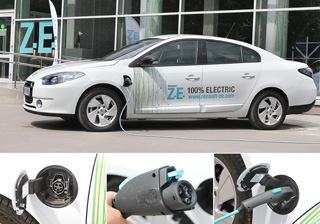
The average daily mileage of private cars in Europe is 60 km. For drivers who pass no more than 150 km per day (for example, to work and vice versa), and manufacturers of electric vehicles are counting on. The energy developed by hydro- or atomic power stations is much cheaper and more environmentally friendly than the usual liquid fuel from oil. But the maintenance and operation of electric vehicles during the entire life cycle (taking into account the utilization of the battery) in cost is not much cheaper than maintenance of an ordinary car equipped with an internal combustion engine. Like it or not, the routine on the creation and operation of the electrical infrastructure lies on the shoulders of the owner. But on the other hand, the more subscribers, the cheaper the infrastructure will cost. So while everything is debatable with electric cars, the advantages of their possession will become obvious only after time
Ideally, it would be generally to do without acceleration and slowdown and overcome all segments of the path so that the actual speed coincides with the average speed. But on the streets this is not real, so we will simply become an unsafe obstacle for other participants in the movement.
I tried to portray something on flime. Several times, at speed, the apparatus was pumped right and left heavy, inert. The steering wheel responds with a noticeable delay and rolls. The large mass and high center of gravity are affected. Well, what do you want 1543 kg (a regular flux weighs 1280 kg) and a vertically located battery. But there are exactly no complaints about the smoothness of the course. The suspension honestly and tightly works out the frightening sizes of the bump. But all the same, it is better to slow down before gentle irregularities. Electric flime strives to swing the ass of a couple of times.
In general, the element of Fluence Z.E. city. The hectic rhythm of accelerations of the METHOD will certainly not be lost on it. But at speeds close to the maximum 135 km/h, you will not get overclocking above a hundred pleasure too long.
But what about Kangoo Z.E.? In fact, the same roller van. Iron, with wheels. Rides, accelerates and even slows down. Spartan double cabin and a naked three -cubed cargo compartment, ready to take 650 kg of cargo. A harsh suspension and an even more modest traction at the maximum 226 Newton of torque, the motor in the maximum develops a power of 44 kW (60 hp). There is nothing more here, the task of Kangoo to carry goods with a minimum energy consumption, and not to participate in sprints. The technical filling is completely identical to Flyunsovskaya. The battery with a capacity of 22 kWh 1.4-ton heel provides range of 170 km. Flyens, by the way, can drive 15 km more!

Electric components Kangoo Z.E. They are combined in such a way that the useful volume of the cargo compartment has not decreased compared to the usual heel. The power plant is located under the hood, the battery under the floor in the middle part of the body
Test electric cars are pre -production samples. But from machines that are prepared in production, they are almost no different. In serial electric cars there will be an advanced navigation system with additional functions of organizing routes taking into account the perimeter of the car and charging points. In addition, they will be equipped with a full-fledged system of dynamic stabilization and track control. Of the experimental vehicles, only on flime there was an anti -wings system, and Kangoo in general decided to limit himself to a regular ABS.

Our test electric carriers during blessings were charged from the usual single-phase 220-volt network. At the top right, a black compact block with diodes and the inscription Z.E. Portable charger
Fluence Z.E. In Europe, about 26,000 euros will go on sale in the fall (VAT in each individual country is different). The price in France will be from 21,300 euros, taking into account the tax benefit of 5,000 euros. Kangoo will appear at the same time, and its value without taxes will be 15,000 euros. But Israel will receive the first electric vehicles. By the way, cars will be sent there in a special performance with more powerful air conditioners and a forced battery cooling system.
And what do we have? In general, the French will also aim in our market. But until the moment it gets up on a wide leg, still far away. It is necessary to solve some technical problems with operation in cold climate. There is still a lot to work on batteries, yet the capacity at low temperatures decreases significantly. A short daylight hours in winter forces a larger amount of time to use the head light, and the need to heat the salon generally reduces all the advantages of the electricity to not. But Renault promises to solve some problems related to the features of operation in Russian conditions in a year and a half.

Fluence Z.E. and kangoo z.e. Already on the way in Israel and Europe, they will appear during the summer-autumn. This year, Renault plans to start the production of a compact city single electric car Twizy (left), and in 2012 a five -door Zoe electricch.
No wonder in the same Norway, despite the 40-degree frosts, about 2000 electric cars were sold over the past year! The familiar electric Mitsubishi I-Miev, which literally this month began to sell, feels good at all in the cold. But Europe is one thing, and another thing is Russia! In the countries of the European Union, the purchase of environmentally friendly cars is stimulated by reducing taxes and the payment of good bonuses. And we even have electric cars taxed.
Renoshniki offer three options for replenishing the battery charge.
1. Standard charging. It can be carried out in any convenient place from a household 220-volt power supply. Charging will take 6-8 hours (current strength 16 a). With a current strength of 10 and charging time can increase to 10 hours.
2. Accelerated charging is possible from a special terminal. He sits on a three-phase 380-volume network and is able to completely charge the battery in 30 minutes.
3. The fastest way to restore the charge simply change the devastated battery to a charged one. Renault in the future offers to build a network of automated Quickdrop stations, on which the battery will change within three minutes. Currently, the construction of replacement points is under cooperation with Better Place in Israel and Denmark. In the latter, it is planned to create 150 such points
Nevertheless, the main obstacle to the operation of electric cars in Russia is the lack of electrical infrastructure. Electrical supplies are simply needed. In Moscow, for example, such a refueling so far is only one on Sadovnicheskaya Street. For comparison: in the UK there are already more than 1000, in Germany under 600. And in Israel and Denmark, it is planned to create 500 thousand such charging stations in the near future.
OJSC MOESK took up the creation of electrical supplies in Moscow. By the end of 2012, the organization promises to make 28 terminals in Moscow. But this, most likely, will not be limited to this, OJSC MOESK plans to create a system that would allow everyone to install stations to everyone. One terminal costs several tens of thousands of euros. Shopping centers, cafes and gas stations could well afford to take a commission in the future from charging electric cars visitors
Vitaly Kabyshev
Photo: Vitaly Kabyshev and Renault




Source: Auto.mail.ru
Video test drives Renault Fluence since 2009
Renault Fluence Crash Test Video since 2009
Test drive by Renault Fluence since 2009
Renault Fluence Crash Test since 2009
Krassh Test: Detailed Information72%
Driver and passengers
37%
Pedestrians
83%
Children-passengers
84%
Active security system

